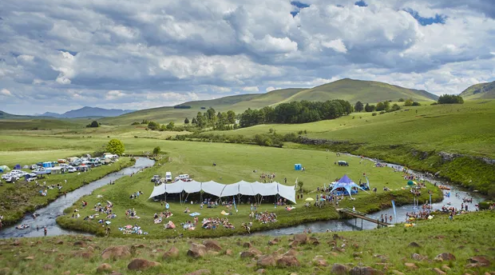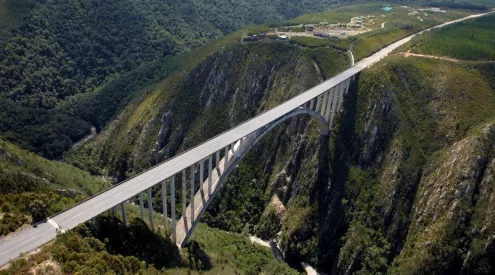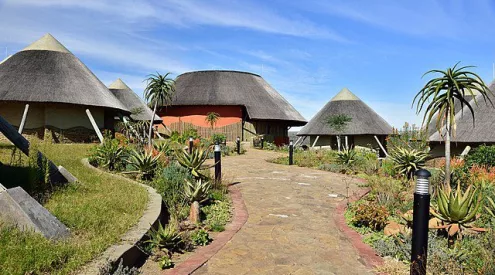Mia Louw’s first-ever multi-day hike was an ambitious trek around the ‘Devil’s Office’.

The first day on the trail offers views of the De Kaap Valley, with Nelspruit and Barberton in the distance.
Duration: 4 days
Type: Self-guided
Level: Fairly strenuous
‘Enjoy your journey!’ bellowed a man behind us as we settled into the rhythm of our second day. He was a forester, felling trees. He would be our first and last human contact on the recently revamped, four-day Blue Swallows Trail near Kaapsehoop in Mpumalanga. We would traverse the Drakensberg plateau, weaving through plantations, crossing valleys, kloofing up clear streams and descending into natural forest, with only baboons and wild horses as witnesses.
The forester’s choice of words clung to us and added weight to the endeavour, much like our hefty backpacks. This was no mere walk but rather a journey. The rocky trail traces the edge of the escarpment, often plunging down cracks in the cliffs and rising up through pockets of natural vegetation. Each time we spotted these sections from a distance, we were filled with both enthusiasm and dread.
‘I bet we’re heading down that cliff,’ my husband Hanc would predict, knowing a heavy workout awaited. Technically, you can cheat and walk sections of the trail along at plantation roads, an idea that tempts you with its ease. But the rewards of the tougher trail include better views, forests and rivers.

Start just after dawn on the first day to reach this fig-tree picnic spot by lunchtime.
Is this perhaps why Kaapsehoop was once called the Devil’s Office? No. The old name came from the oddly shaped sandstone rock formations in the area. They add an eerie atmosphere to the tiny hamlet, which is often covered in a blanket of mist. It was renamed Kaapsehoop when gold was found here during the late 1800s, offering hope to early prospectors. There are still many remains visible from the gold-rush days and the Anglo-Boer War that followed, including herds of wild horses. Local Rudi du Plessis, who used to maintain the hiking trails and huts and now runs Scootours, told me there are an estimated 180 wild horses in the area. It’s difficult to calculate their numbers exactly, as they roam over 17,000 hectares of the Berlin plantation. Although we spotted some of the wild horses on our hike, the endangered blue swallow was nowhere to be seen.

Mia Louw and her husband Hanc in front of Wattles hut.
The Blue Swallow Reserve and the hiking trail were named after the numerous nesting pairs once found in the area, but Rudi says they haven’t been seen for four summers. Another endangered species previously found on the trail but now mysteriously missing is the Kaapsehoop cycad. These used to grow abundantly in Starvation Creek Nature Reserve. Rudi says poaching is to blame. On the third day of the hike, the trail led past an old prospector’s cave, a few steep steps after Jack’s Corner. Legend has it that Jack was an unlucky chap – a miner who had a heart attack at this spot while rolling a big boulder out of the way.
We had luck with our accommodation. All the overnight stops face west towards the sunset, which makes carrying a heavy bottle of wine all the more worth it. One of the stops is at Florence Hill, a large re tower with 360-degree views. After trekking 15 kilometres a day, up hills and down dales, you truly appreciate a sundowner, especially one with a view. After all, as we realised on this journey, the best views and experiences have to be earned.

The bunk beds in the train compartment at Barrett’s Coaches offer the most comfortable night’s rest.
The route
There are multiple trail options, ranging from two to five days, starting at either of the two parking points: Kaapsehoop Hut or Barrett’s Coaches. We did the Blue Swallows four-night trail. It’s a good idea to sleep at Kaapsehoop Hut on the night before you start because it’s a fairly long first day.
Day 1 Kaapsehoop Hut – Florence Hill 16,7Km
One of the highlights of the first day is Adam’s Calendar, a stone circle believed by some to be one of the oldest man-made structures in the world. And, along the last 2km, the trail descends deep into cracks in the cliff s, leading to a picnic spot surrounded by colossal fig trees and festooned with wild orchids hanging from rectangular rocks – just like a scene from The Jungle Book.
Day 2 Florence Hill Hut – Barrett’s Coaches 14,5Km
The walk starts off with a challenging route recently added to the trail, winding through recently felled plantations (which made it diffi cult to spot the little white trail markers painted on rocks and tree stumps). We were also greeted by droves of blackjacks, those tiny little hitchhikers eagerly clinging to everything. The last stretch had us kloofing up a steep river and a series of small waterfalls to reach two railway coaches converted into comfortable, quirky accommodation.

This ancient stone circle was discovered in 2003 and named Adam’s Calendar.
Day 3 Barrett’s Coaches – Wattles Hut 15,3 Km
A highpoint of this day is the view from the top of Starvation Creek Falls. I’ve never been more jealous of baboons, as they effortlessly scaled the cliffs surrounding the cascading water. The trail ends with crossing a stream surrounded by tree ferns to reach the overnight hut. It’s an old forestry house (recently renovated – we could still smell the fresh paint), with wooden floors, a large stoep, a wood-burning stove and fireplace.
Day 4 Wattles Hut – Kaapsehoop Hut 13,8Km
This is the easiest day. Shortly after leaving Wattles, you’ll pass an SABC broadcast tower – an unexpected reminder of civilisation after so much wilderness.

Battery Creek Falls is named after a stamping mill (or stamp battery) used during the gold-rush days to crush rock.
Plan your trip
Getting There
The hike starts and ends in Kaapsehoop. From Nelspruit, take the Hermansburg road to the Kaapsehoop Pass and Ngodwana (30km). From Joburg, take the N12 to Emalahleni and the N4 towards Waterval Boven, turning off onto the Kaapsehoop Pass at Ngodwana (311km).
Need To Know
You need to be fairly fit to do this hike. There are streams, rivers and dams along the route, but we struggled to fi nd the drinking-water points indicated on the map. Carry enough water for each day and fill up at the overnight stops. Barrett’s Coaches has electricity; the huts have donkey boilers with firewood stacked for a warm shower or braai. Only Barrett’s Coaches could be locked from the inside, but Rudi told us there have never been any safety issues at the accommodation or on the trail. Plantation roads are fairly close to the trail, making access easy in case of an emergency, and there is cellphone reception.
When To Go
The hike can be done all year round. During the day it’s around 25°C in summer and around 17°C in winter. With parts of the trail at 1 628 metres above sea level, nights can get rather cold (in winter, as low as 3°C). There is regular mist and reasonably high rainfall, particularly in summer, so pack a poncho and a raincover for your backpack.
What To Bring
A camping gas-burner if you prefer not to do all your cooking on coals. There were some kitchen utensils at Florence Hill, but it’s best to bring your own. There are beds and mattresses in all the huts (16 at Kaapsehoop, 10 at Florence Hill, 24 at Wattles and 24 in one coach at Barrett’s).
Booking
Hiking costs R130 pp per day. There is a slackpacking option, with portage for R350 to R450 per hut for four hikers. 013-754-2724, safcol.co.za

When Florence Hill Hut replaced the old option, this altered the first day’s route slightly.
While you’re here…
• On your way back to Kaapsehoop on the last day, visit the cemetery just before entering town. Some graves date back to the late 1800s, and it has a spectacular view of the area and the top of Battery Creek Falls. You can also walk to the bottom of the falls from town – a day excursion (dogs allowed) with a permit, R15 per person from Salvador Mainstreet Bistro.
• Take a tour through the plantations and forests on a Monster mountain scooter with Scootours. The routes often meet up with sections of the hiking trail. R450 pp. 066-305-9404
• Treat yourself after the hike and check in at Silver Mist Country Inn, next to the quaint church and old jail in the village square. From R760 per person DB&B.
013-734-4429

























